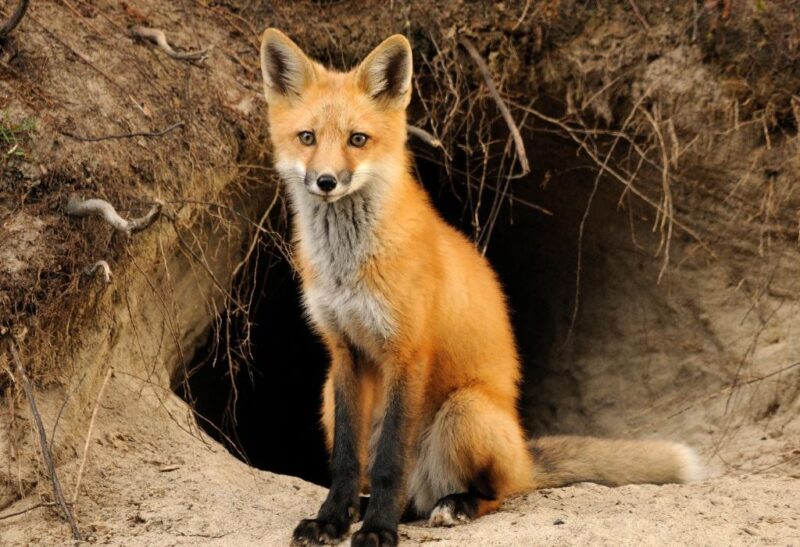When the fox is alone, it prefers to lie on open ground. However, just like humans, things change for them when they become parents. The pups need warmth and protection from moist microclimate and predators as they grow, so an underground den is made for them in spring.
A fox dens are made taller than broad, with a height from 20 to 70 cm and a width of 30 to 40 cm. The opening is usually round, but some dens are oval as it depends on the soil type. The larger the den, the more openings there are. Excavated dirt can be found around every opening.
Natal dens have 9 or more openings during the whelping season. However, there are only one or two openings on temporary or escape dens during breeding and dispersal periods.
These dens can be found within the foxes’ territory or in secluded areas. The den structure differs from species to species. Learn more by reading this article.
Table of Contents
What Do Fox Dens Look Like in Spring?

In the UK and Australia, fox dens are found under garden sheds or some buildings in spring. There’s a hole that has a one-foot diameter surrounded by a mound of fresh dirt. Some animal remains can be found a few feet away from the said hole. These are the proof of the foxes’ predation.
Foxes choose to make a new den near the previous one. They would dig the den in well-drained soil, usually along a steep bank. The parent foxes can use this section as a lookout for predators. A well-traveled trail that leads to the main denning site can be found. Secondary openings have less-pronounced trails.
What Does an Arctic Fox Den Look Like?
The dens of Arctic foxes are located on slopes, 0-45° and at altitudes of 5 to 380 m. Moreover, these dens are built under rock crevices and large stones along the valley hillside or coast. Some are in sand and vegetation, although snow only disappears in their location in July or August.
Arctic foxes make sure that they have a dry den. The openings of their dens are approximately 400 to 500 square meters.
What Does a Desert Fox Den Look Like?
Generally, desert foxes choose to make smaller openings in their dens to prohibit large predators from entering. Nonetheless, the non-natal dens have taller openings. This shows that desert foxes are so protective of their young.
Researchers also focused on the vegetation surrounding the dens of desert foxes. Dens with multiple openings are found with the lowest mean vegetation height and covering of shrubs. The natal dens have the highest amount of vegetation and cover, so they can hide while watching if there’s a nearby predator.
On the other hand, desert foxes have an open view in detecting predators if the vegetation around their dens is not too thick. These foxes mostly build their dens in earthen areas, while a few do it in rocky areas.
What Does an Urban Fox Den Look Like?
The den of an urban fox is usually found in overgrown shrubberies and disused gardens. Their preferred locations are under a garden shed or some buildings. The opening of the den has a mound of dirt.
Fox Den Under a Tree
It’s natural for a fox to have a den under a tree which can conceal the entrance from the knowledge of the predators.
How Deep Are Fox Dens?
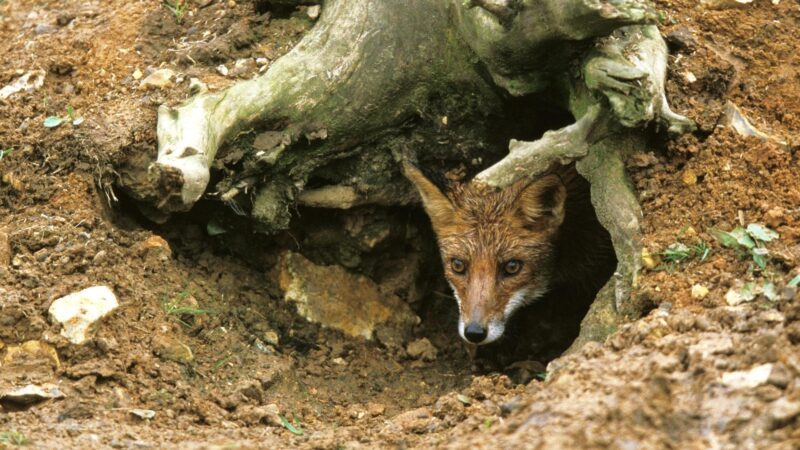
The entrance tunnel goes into 16 to 23 feet, but the whole den can be up to 56 feet deep.
How to Find Fox Dens?
Aside from the round entrance surrounded by excavated dirt, you can find fox dens by using your sense of smell. It’s possible as foxes tend to mark their territory with their urine. The area will be covered with a strong, distinct ammonia smell. If you have a hint of it, the den is surely nearby.
Foxes poop near their dens, so if you smell and see a scat, it’s another clue that their dens are nearby. Foot traffic is another sign, especially if it leads to a tree or vegetation. It’s easier to find a fox den in urban areas as these animals are destructive.
It’s the opposite in tundra or forest. You’ll need to practice how to track the fox den in these remote locations.
Where Do Fox Build Their Dens?
Foxes normally build their dens under hollow trees or stumps. They also like areas with thick vegetation and loose soil for easy digging. In addition, they make dens under buildings too.
Do Foxes Share Their Dens?

Foxes, specifically desert foxes like fennec foxes and Arctic foxes that live in tundra share their dens. It’s a practice because these fox species live as a social family group.
How Can You Tell a Fox Den?
The ammonia smell of foxes’ urine and their scat will tell you that a fox den is nearby. Also, the hole is relatively bigger than the ones made by mammals who are ground dwellers. The opening can be as wide as 30 cm and as tall as 20 cm. But some foxes would occupy the dens made by other animals.
How to Tell the Difference Between a Skunk and Fox Dens?
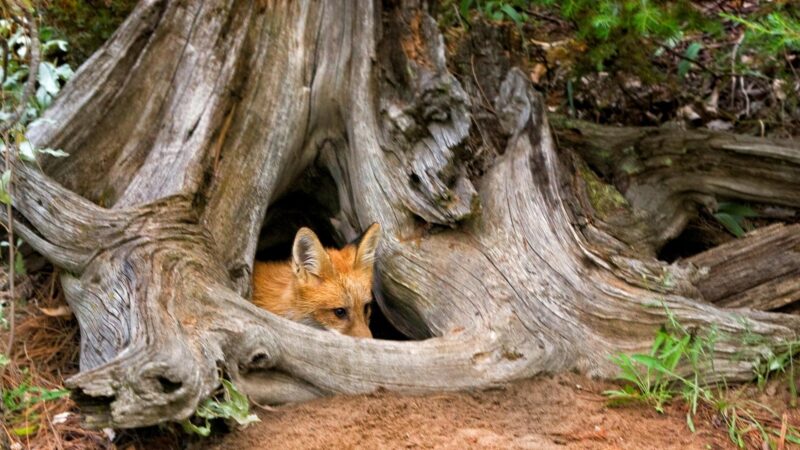
The dens of skunk and fox may look similar as there are larger holes with a diameter of 6 to 12 inches. Both of these animals build their dens near the tree, walls, and stumps.
To identify which is which, you need to base it on the odor you can smell around the den. Skunk emits a musky scent, while foxes leave their urine with a strong, ammonia-like smell.
How to Seal Fox Dens Around Homes?
You need to check first if the fox is in the den. Try to poke it, and it will run away. The den should be sealed with something heavy like a rock, so the fox can’t dig it. You can also build a fox-proof run made of heavy welded mesh or chain link fence, which the fox can’t penetrate.
- ADJUSTABLE GATE KIT: Make sure your chain link gate is always on...
- SPECIFICATIONS: Outdoor gate kit measures 1.38” x 70” x 72”...
- EASY INSTALLATION: Install on-site to perfectly fit your gate...
- DURABLE MATERIAL: Fence post kit is built with a strong,...
- INCLUSIONS: Gate installation kit includes steel gate frame,...
Fox Den Behaviors and Habits
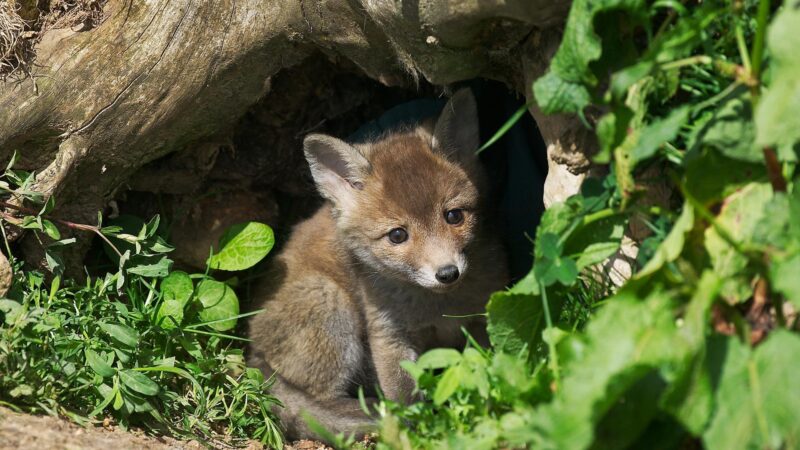
Male foxes rarely stay in dens. It’s the vixens who would use the dens for rearing the pups. Apart from having young, foxes need the burrow due to harsh weather conditions and inadequate vegetation that they use for cover.
As stated in the book ‘Running with the Fox’ written by David Macdonald, some vixens will share a den with one or two female foxes in winter. Furthermore, it was also discovered that these vixens have their resting dens apart from what they share.
This discovery leads to the conclusion that sharing dens is practiced among families. Foxes stay in their dens most of the time if there’s population growth. So, they can keep their chosen sites for themselves alone.
Feeding Kits Inside the Den
In the first four months, the pups will be fed milk. The vixen stays with its pups inside the den while the father hunts for food that is given to their babies. They start eating solid food when they’re three months old.
The vixen or the mother fox will leave food in a pattern that leads to the entrance of the den day by day. This is a way to teach the young how to come out of their dens. At a certain point, the mother will leave the food outside the den so the pups will learn how to forage and hunt on their own.
Fox Den Food Caches
The amount of food that foxes store in their dens is enough for mating season and winter. But some may just store food that is good for a few days. They usually store fruits and berries. The first thing they consume is the meat they brought into the den.
Do Foxes Have Multiple Dens?
As mentioned, some foxes share the same den in winter, but they have their exclusive resting site. Hence, they may have multiple dens, but a vixen will use one den where she nurtures her pups for a year. They may use a certain den again in the future.
Foxes only leave their dens because of predators, when humans chase them, and there’s food scarcity in the area.
Foxes Inheriting Dens
In Europe, there are fox dens that were built hundreds of years ago. This is proof that foxes inherit dens from their ancestors.
Foxes Borrowing and Stealing Dens
Foxes sometimes share a den with a rabbit and other woodland animals in extreme and desperate instances. They can live peacefully with other creatures but the setting changes when the danger is over.
When foxes travel, or they need a new place, they borrow a den from other animals. It will be to the extent that they steal it and make some renovations based on their standards.
Fox Den Diagram
A fox den begins with an entrance and a ramp of 40 to 45 degrees. This ramp acts like a corridor that goes 3 to 8 feet deep. It’s the section that connects the main entrance and the main den. There’s room to store food inside the den, and some additional rooms are added for a larger pack.
The foxes ensure that the den is big enough for giving birth and raising the young. Some make more tunnels for extra entrance and exit passages.
Are Fox Dens Protected?
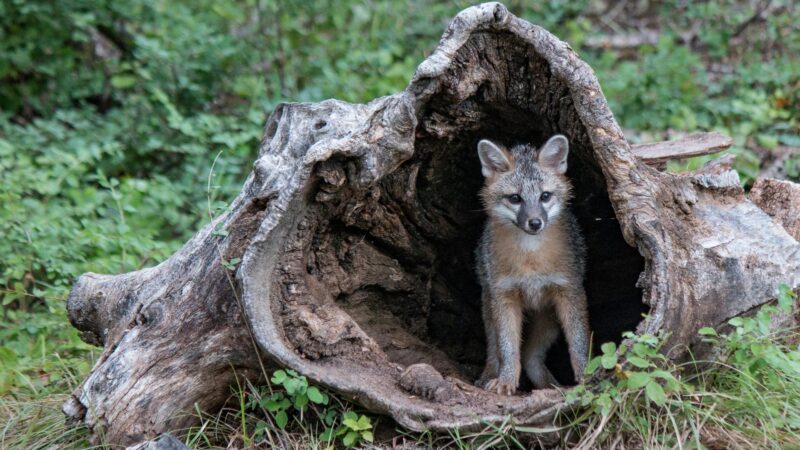
Fox dens are protected in some areas where foxes are endangered. Some areas in the United States even build fences around these dens. Some Arctic foxes in the tundra are also protected as their dens have been there for 100 or 200 years.
How Long Do Foxes Stay In a Den?
The duration that foxes stay in a den varies since it depends on the species and location. For instance, red foxes utilize for breeding, but some species stay longer or even have it as a permanent home, like desert foxes.
Do Foxes Make Their Dens Close to Each Other?

Provided that there’s enough supply of water and food, 2 or 3 dens are made within an area of 10 square miles. Only one den is built in an area of 20 square miles with low resources.
Are Fox Dens Safe for Foxes?
Fox dens are safe for foxes as they can build the rooms well regardless of location. They’re excellent diggers, so dens are fortified in the ground, around large rocks, or on the ice. There’s a tendency that it might collapse, but it rarely happens as some fox dens remain for hundreds of years.
Fox dens are used as temporary dwellings for the breeding season or as an asylum for harsh weather conditions. But it’s a permanent house for desert foxes, and Arctic foxes as these species need cover for extreme heat and low temperature. All in all, foxes create tunnels and rooms that can protect them from large predators and bad weather.
List of Sources
McGee, B. K., et al. (2006). Characteristics of Swift Fox Dens in Northwest Texas. Western North American Naturalist.
Arjo, W. M., Bennett, T. J., Kozlowski, A. J. (2003). Characteristics of current and historical kit fox (Vulpes macrotis) dens in the Great Basin Desert. University of Nebraska – Lincoln.
Learn about foxes. Commonwealth of Massachusetts.
Weber, D. (1982). Fox den sites and the patterns of their use. Comparative immunology, microbiology and infectious diseases.
